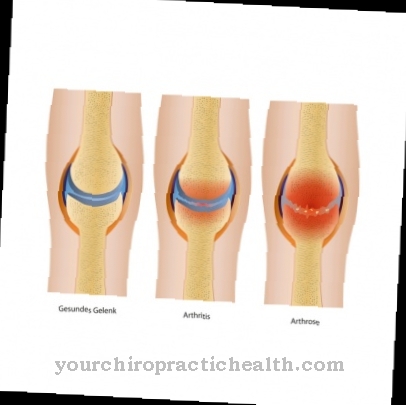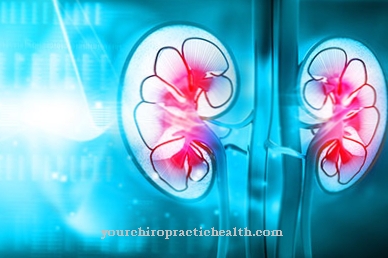The Restless legs syndrome, RLS or colloquial too restless legs called, is a disease, the causes of which are still largely unknown. Symptoms can be countered with various medical approaches.
What is restless legs syndrome?
.jpg)
© Antonioguillem - stock.adobe.com
At the Restless legs syndrome is a neurological disorder that mostly affects a patient's legs and feet. In rarer cases, restless legs syndrome affects the arms. Translated into German, the Restless Legs Syndrome means 'syndrome of restless legs'.
Symptoms of the disease include a strong urge to move and sensory disorders in the legs or arms. In addition, the restless legs syndrome can lead to involuntary movements in those affected, which often increase in situations of rest or during sleep.
A distinction is made, for example, between the idiopathic (independent) and the secondary (developing on the basis of other disorders) form of restless legs syndrome.
According to estimates, the Restless Legs Syndrome occurs in around 5-10% of the population in Germany; Women tend to be more often affected by restless legs syndrome than men.
causes
What causes the Restless legs syndrome the basis has not yet been conclusively clarified in science; Among other things, it is assumed that the concentration of the neurotransmitter dopamine (a messenger substance of the nervous system, which is colloquially known as the happiness hormone) and the influence of motor disorders (disorders of the musculoskeletal system) on the restless legs syndrome are assumed.
It is also possible that various nerve tracts in those affected by Restless Legs Syndrome react with above-average sensitivity or over-excitability.
Restless legs syndrome in its secondary form can be caused, for example, by neurological diseases (such as Parkinson's disease), deficiency symptoms or various medications. If the restless legs syndrome is idiopathic (independent), genetic causes are assumed in medicine.
Symptoms, ailments & signs
Symptomatic is an agonizing urge to move in the legs in a resting posture. This can take the form of tearing, pulling, or burning sensation during uncontrolled muscle movements. The involuntary muscle twitching occurs both when you are awake and when you are asleep. The calves are often affected.
Periodic leg movements occur during sleep, which lead to frequent waking. The symptoms set in increasingly in the evening and at night and can set in on one or both sides. The abnormal sensations can hardly be felt, but can also occur intensely for a short or long period of time. In more severe cases, Restless Legs Syndrome (RLS) can lead to significant sleep disorders despite the presence of fatigue.
These can last until early morning. Due to the tiredness during the day, considerable problems in coping with everyday life can arise the next day. These include poor concentration, bad mood, irritability and depressive moods. Microsleep while driving can indicate the cause of restless legs syndrome. Itching, pain and numbness can also be signs of restless legs syndrome.
In addition, an excessively rumpled bed in the morning, frequent waking up and getting up indicate this clinical picture. A sign of RLS disease can also impair well-being while sitting during the day. Sensory disturbances in the legs can also include an unnatural feeling of cold or heat. A typical feature of restless legs syndrome is the improvement in symptoms through exercise.
Diagnosis & course
That is diagnosed Restless legs syndrome usually by a neurologist (also known as a neurologist). A corresponding suspected diagnosis is often first made on the basis of the symptoms that can be observed or the symptoms described by the patient.
There are also various tests available to the neurologist that can confirm the diagnosis of Restless Legs Syndrome: A corresponding test consists, for example, of a single administration of L-Dopa (an active ingredient that is used, among other things, for dopamine deficiency); if the symptoms improve as a result of this administration, this speaks for restless legs syndrome.
The course of the syndrome depends, among other things, on the form of the restless legs syndrome: If it is the idiopathic (independent) form, the onset of the disease can often be observed in those affected in the third decade of life. In idiopathic restless legs syndrome, a moderate (but often not continuous) increase in symptoms can be observed over the course of a person's life.
In general, the symptoms of restless legs syndrome are relatively mild, so that drug treatment can be dispensed with in most cases.
Complications
Restless legs syndrome does not cause any physical complications. However, the excruciating tingling sensation, pain and restlessness mainly occur during times of calm. Because of this, the organism cannot relax. Furthermore, the symptoms intensify in the evening before going to bed, so that falling asleep and staying asleep is not possible.
The result is that many sufferers suffer from lack of sleep and feel extremely tired and weak during the day. Often they find it difficult to cope with daily life because they are exhausted, depressed and lacking in drive. This means that patients with RLS can lose their full potential. As a result, those affected often experience negative social effects due to their tiredness and their constant urge to move.
Sitting together with friends and acquaintances for a long time is not possible because there is always the urge to keep walking around. Since friends and family often do not understand this behavior either, it is not uncommon for social isolation to occur. On this basis, the psychological well-being of the sick is severely impaired.
Restless legs syndrome can be the cause of other mental illnesses. Social isolation increases the risk of depression and suicidal ideation. In order to increase the quality of life of those affected, psychotherapeutic support from a psychologist is recommended in addition to drug treatment of the syndrome.
When should you go to the doctor?
Having restless legs is not in itself a disease. Excessive caffeine consumption or nervousness can be the cause.
However, if there is restless legs syndrome, it can be assumed to be disease value. It is a more or less pronounced neurological disorder. This requires a visit to a neurologist. Restless legs syndrome, for example, can occur as a side effect of taking antidepressants.
Restless legs syndrome affects around 5-10 percent of the population. Medical treatment is only necessary for every fifth person affected, namely with very strong symptoms. It is mostly a perceived level of suffering that drives people to see a doctor. A strong urge to move, which mostly affects the legs, reduces the quality of life.
If increasing social isolation and avoidance of sedentary activities result from the restless legs syndrome, the doctor's visit should not be postponed anymore. The doctor may be able to identify and correct the causes of restless legs syndrome. For example, if there are drug side effects, other drugs with identical main active ingredients may be prescribed.
In other cases, dampening preparations can be prescribed that alleviate the symptoms of restless legs syndrome. It should be noted that other medications are often already being taken. These must be compatible with each other. The doctor should therefore find out which illnesses the person concerned suffers from and which medications they must take regularly.
Treatment & Therapy
Medical treatment at Restless legs syndrome is usually based on the suffering of the individual patient. Since the restless legs syndrome often contributes to impairment of the quality of sleep, therapy in many cases starts with a corresponding improvement.
Patients in whom the restless legs syndrome is associated with pronounced symptoms and a high level of distress are often treated with medication; Such treatment can be continuous or needs-based, depending on the symptoms. In the restless legs syndrome, for example, active ingredients are used that represent a precursor of the neurotransmitter dopamine and are converted into dopamine by the body.
So-called dopamine agonists (substances that are similar to dopamine) are also used in restless legs syndrome: These substances can help to sensitize nerve cells to the absorption of dopamine. If the restless legs syndrome is relatively mild, non-medicinal procedures such as massages are sometimes used.
Some patients also describe hot or cold showers as relieving. If the restless legs syndrome is in a secondary form, therapy usually starts first with combating the corresponding underlying diseases or disorders.
You can find your medication here
➔ Medicines for paresthesia and circulatory disordersprevention
Since the causes of the Restless legs syndrome have not yet been conclusively clarified, there are currently hardly any ways to prevent the syndrome. In order to prevent restless legs syndrome from developing in a secondary form, consistent therapy for possible underlying diseases can be helpful.
Aftercare
Since restless legs syndrome cannot be completely cured, follow-up treatment for restless legs syndrome is closely related to its therapy. It is therefore necessary to take medication for life even after the symptoms of Restless Legs Syndrome have subsided. The goal of follow-up treatment should be to prevent the need to take opiates if they are not already being used for restless legs syndrome.
Long-term use of opiates can damage organs. Because of the medication intake, regular blood tests should be carried out as follow-up treatment. Liver and kidney function values in particular must be monitored intensively. If this deteriorates seriously, you have to switch to another drug.
In addition, checking iron levels and taking iron supplements if necessary can prevent the disease from breaking out again or worsening symptoms. If possible, you should avoid taking sleeping pills (Z-drugs), antidepressants, neuroleptics and beta blockers, as these drugs can aggravate or cause the restless legs syndrome to break out again.
A healthy sleep hygiene, i.e. a regular sleep rhythm with sufficient recovery phases, is beneficial in the long term against the restless legs syndrome. In addition, physical activity that stresses the legs is good for their blood circulation. In this way, symptoms can be prevented from getting worse. Caffeine and stimulants, including nicotine, should be avoided.
You can do that yourself
People who have restless legs syndrome can also help themselves to at least alleviate the symptoms. For example, when the restless legs appear, it helps many to take a cold shower. The cold causes the blood vessels to contract and the nerves also calm down. In addition, patients describe a positive effect from exercise. The restlessness can be alleviated by taking regular walks in the evening. Yoga and Pilates also calm you down.
In addition, a healthy and balanced diet is very important in RLS. Bad food often creates a nutritional deficiency in the body.A lack of magnesium and iron in particular are associated with the restless legs. This memory can best be replenished through food. Avoid alcohol and too much sugar. Many patients also describe an improvement in symptoms through targeted massage of the legs, especially the affected areas.
Since the causes of RLS have not yet been conclusively researched, regular relaxation exercises can also help to lower the stress level in the body and thus calm the nerves. It is important that the symptoms do not go away overnight, but only take effect after a few weeks.






.jpg)






.jpg)

.jpg)
.jpg)











.jpg)